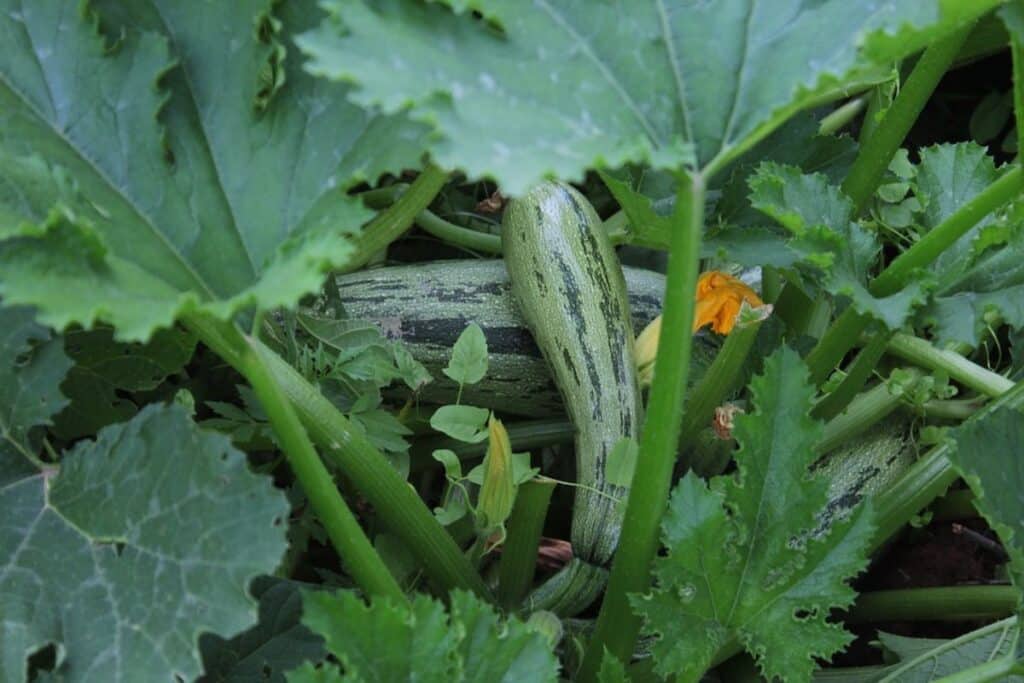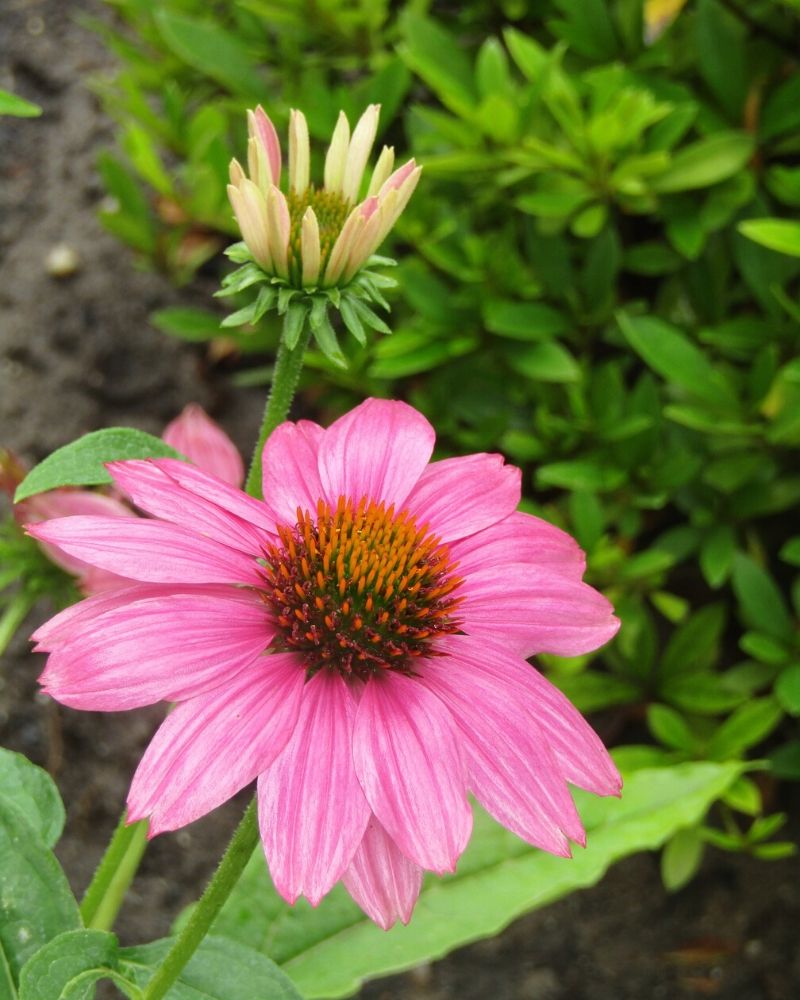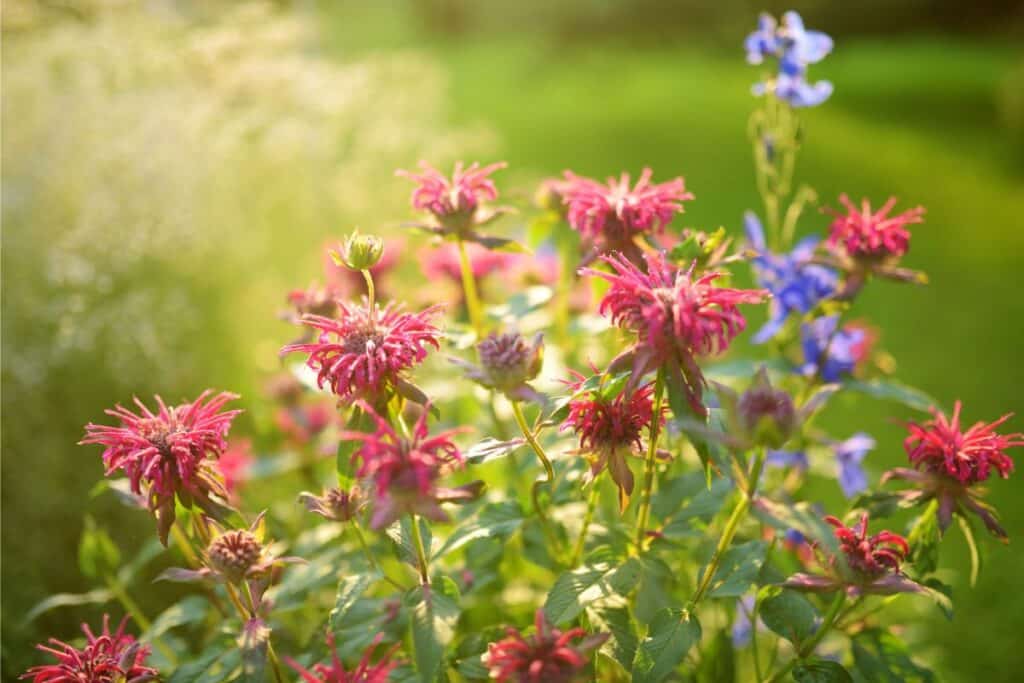Bee balm (Monarda) is one of the most useful plants you can add to your garden. This member of the mint family is often referred to as bergamot, horsemint, and oswego tea.
Even though bee balm is used in fragrant oils (some very strongly scented oils, in fact!) and has many medicinal uses, many gardeners choose to grow it because it can benefit the other plants in your garden so much.
The beautiful flowers that bee balm produces attract lots of beneficial insects while the seed heads attract bird species to your garden. The fragrant scent of this herb can also deter common garden pests. It’s an ideal plant for a pollinator garden.
The best way to enjoy all of the advantages that this herb has to offer is by pairing it with plant species that can benefit from the powerful effects of bee balm.
Let’s take a look at some of the best bee balm companion plants to consider for a beautiful and pest-free garden.
What Plants Work Well With Bee Balm?
Before planning out your landscaping bee balm companions, you need to know how to care for bee balm and its growing conditions. There are several types of monarda, including monarda didyma, but all have the same general care guidelines.
Bee balm is a very versatile companion plant because it can be successfully grown in the same bed as all other bee balm varieties as well as many different annuals, perennials, and herbs.
The easiest way to find the best companions for your garden is by selecting species that have a similar growing requirement as bee balm.
The bergamot plant grows at its best when it is established in full sun with a minimum of 6 hours of direct sunlight per day. You can establish this herb in partial shade but this will affect its ability to produce flowers and might make the herb vulnerable to powdery mildew.
Bee balm should be grown in nutrient-rich, moist but well-draining soil and it prefers a neutral pH level.
Let’s do some matchmaking and see what plants to grow alongside bee balm plants.
Tomatoes
Tomato plants (Solanum lycopersicum) is a vegetable plant that can use all the help they can get because it is vulnerable to a great many pests and diseases. These bee balm companion plants are some of the best when it comes to protecting both crops from harm.
Bee balm can help protect your tomato plants from common pests like aphids, whiteflies, spider mites, stalk borers, and thrips because it will act as a trap crop to lure these pests away from your tomatoes.
These two plants can grow well in the same garden bed because tomatoes also require plenty of direct sun, nutrient-rich soil, and frequent watering in order to flourish. Tomatoes do however prefer a slightly higher acidic soil type with a pH level of 6.2. Bee balm plants can however grow pretty well even if the pH is a little bit higher.
Bee balm is a perennial while tomatoes are annuals. To reduce garden maintenance, it is best to establish them in separate rows close to one another. This way you can easily remove the tomatoes when the harvest season is over or clear out the bee balms if they become too infested.
Squash

Squash plants (Cucurbita) like butternut squash, zucchini, yellow summer squash, hubbard squash, acorn squash, and most other varieties can also benefit from the effects that bee balm offers. It can repel all kinds of plant and soil pests.
The bergamot fragrance will lure carnivorous insects like lady beetles, green lacewings, and paper wasps to your garden. These beneficial insects will feed on pests like aphids and caterpillars that often attack squash plants. The bee balm plant will also attract pollinators that can help increase your squash yields.
Squash varieties will grow very well in the same soil type as bee balm because these vine plants prefer well-draining soil and they flourish in direct sunlight. But this isn’t the only thing that make squash some of the best bee balm companion plants!
When you grow bee balm with squash, you should be careful to leave plenty of room for the squash to grow. All squash varieties have vigorous growth that can quickly take over a large area.
The bee balm can survive in the dappled shade created by the gigantic squash plant leaves but won’t be as effective since they won’t flower. It is best to establish bee balm in a separate row or to tie the squash up on a trellis.
Phlox
Summer phlox (Phlox paniculata) is often grown along with bee balm because phlox has a very similar look and height.
Phlox is one of the most ideal bee balm companion plants if you want to add a bit of color to your vegetable or herb garden because it produces beautiful pink, rose, red lavender, purple, orange, or white flowers that will add lots of contrast.
This plant will also attract pollinators like butterflies, bees, and hummingbirds to your garden and they create a helpful ground cover that can keep weeds from sprouting in your beds.
It is pretty easy to establish and grow phlox in your garden as bee balm companion plants. This low-maintenance plant prefers full sun but will also grow well in partial shade. These flowering bee balm companion plants also need well-drained and humus-rich soil.
It is best to select phlox varieties that will complement the color of scarlet bee balm. Phlox plants tend to be a little bit shorter than bee balm. If you want the phlox to receive enough sunlight then you should leave plenty of room for these plants to branch out or establish the shorter phlox in a row in front of the taller bee balm.
Black-Eyed Susans

The black-eyed Susan (Rudbeckia hirta) is a plant that is frequently seen in ornamental and vegetable gardens because it can lure lots of helpful insects to your garden and it produces masses of striking yellow flowers.
Black-eyed susans are great companion plants for bee balm because the vivid yellow flowers will create plenty of contrast alongside the bright colors of bee balm flowers. Bee balm will also help repel insect pests that tend to attack your black-eyed susans.
These daisylike flowers thrive in full sun to light shade and they need well-drained moist soil in order to grow properly. These are similar conditions as what is needed by bee balm, making these excellent bee balm companion plants.
You should be careful to leave plenty of space when you grow black-eyed Susan plants and bee balms in the same garden bed. Both of these flowering plants can grow vigorously and might start competing for space and nutrients if they are grown too close together.
See more: Companion plants for black-eyed Susans
Purple Coneflower

Coneflower (Echinacea purpurea) is a great companion plant to consider for a herb or medicinal garden. This is because coneflower also has many health benefits and it can also be used to brew teas.
Echinacea flowers can also strengthen your garden because these perennial plants attract bees and other pollinators to your garden. Besides their physical benefits, they will also enhance aesthetics with flowers that range from white to deep purple in color.
Coneflowers grow very well in full or part sun and they prefer well-drained sandy soil. These flowers can, however, also grow well in the fertile soil required for bee balm.
It is best to plant purple coneflowers and bee balms in the same garden bed because they are about the same height. Adding them to the same garden bed will also keep the bee balm from spreading too much in a small garden.
What NOT to Plant with Bee Balm
You should not grow tall plants and short full-sun plants next to bee balm because they have different growing requirements.
Some varieties might also be poor companions because they increase the risk of developing powdery mildew.
Here is a quick look at some bad companion plants that you shouldn’t include in your bee balm garden bed.
Taller Plants
When you plant bee balm next to taller plants, these perennial plant species might not get enough sunlight. This will affect the bee balm’s ability to produce flowers and can stunt its growth.
Bee balm that is constantly in shade has an increased risk of developing powdery mildew. If you are going to add tall plants to your garden then you should leave plenty of space so both plants can receive adequate sunlight.
Shorter Sun-loving Plants
Short plant species like thyme won’t affect your bee balm plant but might not grow well in your garden bed because the shorter plants won’t receive enough sunlight.
If you want to add shorter plants for bee balm as a ground cover then you should be careful to choose shade-loving varieties like violas that can thrive without sunlight.
A Few More Thoughts on Planting Bee Balm Companion Plants – and Creating a Pollinator Garden
When designing your pollinator garden, consider the placement of plants and how they’ll grow and interact with one another. Grouping plants of the same species and color together can create a stunning effect, but also consider blending colors and textures for a more natural look. Consider adding other elements like rocks, birdbaths, and native grasses to provide shelter and additional habitat for pollinators.
Once your pollinator garden is established, there are a few things to keep in mind to keep it thriving. Deadhead spent flowers regularly, water as needed, and keep an eye out for pests like aphids and spider mites.
Consider planting a variety of bee balm species and bee balm companion plants to ensure a longer bloom time and to create a more diverse ecosystem.
Bee balm is a very useful plant that can add a lot of interest to your garden. This gorgeous flowering plant can also boost the health and growth of other plants like tomatoes, squash, phlox, black-eyed susans plants, coneflowers, and many others you might have in your garden.
Again, bee balm grows best in full sun and moist soil – so when you’re choosing bee balm companion plants, choose those that have similar requirements.
We hope that our guide made it a little bit easier to select the best companions for your garden. And if you are also looking for great companions to pair with other plant species then you should have a look at some of our other guides. With our site, you can find all the latest and best information on just about any plant.
See more: Bee balm flower meaning
References
Reference List
https://plants.ces.ncsu.edu/plants/monarda-didyma/
https://plantvillage.psu.edu/topics/tomato/infos
https://ag.umass.edu/vegetable/fact-sheets/hornworm-tomato
https://gardeningsolutions.ifas.ufl.edu/plants/edibles/vegetables/winter-squash.html
https://plants.ces.ncsu.edu/plants/phlox/
Close
*image by MNStudio/depositphotos







